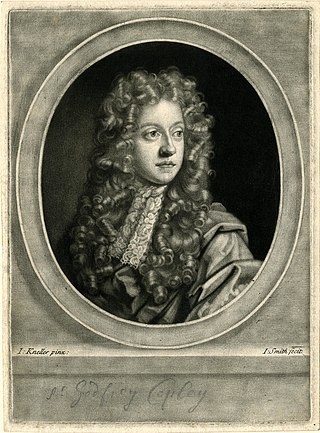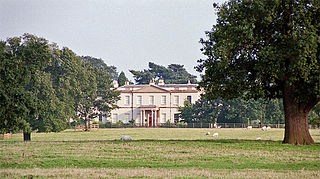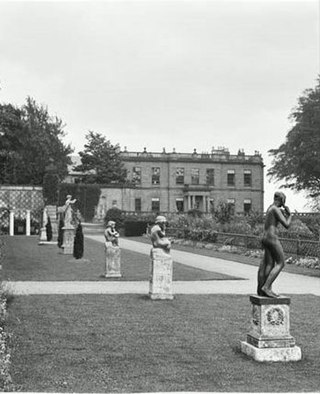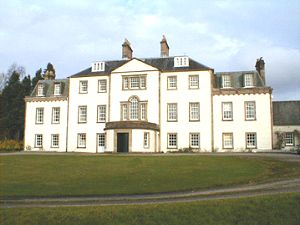
Doncaster is a city in South Yorkshire, England. Named after the River Don, it is the administrative centre of the larger City of Doncaster, and is the second largest settlement in South Yorkshire after Sheffield. Noted for its horse racing and railway history, it is situated in the Don Valley on the western edge of the Humberhead Levels and east of the Pennines. The urban subdivision had a population of 113,566 at the 2021 census, whilst the City of Doncaster metropolitan borough had a population of 308,106.

Sir Godfrey Copley, 2nd Baronet FRS of Sprotbrough House, near Doncaster, West Riding of Yorkshire, was an English landowner, art-collector and Tory politician who sat in the English and British House of Commons between 1679 and 1709.

Duart Castle, or Caisteal Dhubhairt in Scottish Gaelic, is a castle on the Isle of Mull, beside the Sound of Mull off the west coast of Scotland, within the council area of Argyll and Bute. The castle dates back to the 13th century and is the seat of Clan MacLean. One source states that the castle was "brought back from ruin in 1911". The regimental colours of the WW1 Canadian Expeditionary Force 236th Battalion, CEF are laid up in the Great Hall.

Brigadier Sir Fitzroy Hew Royle Maclean, 1st Baronet, was a British Army officer, writer and politician. He was a Unionist Member of Parliament (MP) from 1941 to 1974 and was one of only two men who during the Second World War enlisted in the British Army as a private and rose to the rank of brigadier, the other being future fellow Conservative MP Enoch Powell.

Sledmere House is a Grade I listed Georgian country house, containing Chippendale, Sheraton and French furnishings and many fine pictures, set within a park designed by Capability Brown. It is located in the village of Sledmere, between Driffield and Malton, in the East Riding of Yorkshire, England. The present house was begun in 1751, extended in the 1790s, and rebuilt after a fire in 1911. It was once the home of Colonel Sir Mark Sykes, 6th Baronet, noted English traveller and diplomatic advisor, and is now the home of Sir Tatton Sykes, 8th Baronet.

Charles Hector Fitzroy Maclean, Baron Maclean, was Lord Chamberlain to Elizabeth II of the United Kingdom from 1971 to 1984. He became the 27th Clan Chief of Clan Maclean of Duart in 1936 at the death of his grandfather.
Sprotbrough and Cusworth is a civil parish in the City of Doncaster in South Yorkshire, England, with most of its settlements on the western edge of the Doncaster built-up area. It lies between 1 mile (1.6 km) and 4 miles (6.4 km) to the west of Doncaster and is split by the A1(M) motorway. It had a population of 12,166 in 2001 and 12,134 at the 2011 Census. The parish covers some of Doncaster's outlying western suburbs and commuter belt including the villages of Sprotbrough, Cusworth, and a small part of Scawsby, in addition to several rural hamlets and farmsteads.

The Sheriff is the oldest secular office under the Crown. Formerly the Sheriff was the principal law enforcement officer in the county but over the centuries most of the responsibilities associated with the post have been transferred elsewhere or are now defunct, so that its functions are now largely ceremonial.

There have been two baronetcies created for persons with the surname Maclean, one in the Baronetage of Nova Scotia and one in the Baronetage of the United Kingdom. Both creations are extant as of 2010.

Cantley Hall is a grade II* listed Georgian mansion set in 400 acres (160 ha), in the village of Old Cantley in Doncaster, South Yorkshire, England.

Edwin Hughes, nicknamed "Balaclava Ned", was a British Army soldier and the last survivor of the famous Charge of the Light Brigade during the Crimean War of 1854–56.

The Queen's Own Yorkshire Dragoons was a yeomanry regiment of the British Army in existence from 1794 to 1956. It was formed as a volunteer cavalry force in 1794 during the French Revolutionary Wars. Its volunteer companies played an active role with the Imperial Yeomanry in the Second Boer War, but opportunities for mounted action were much more restricted during the First World War and it was temporarily converted into a cycle unit. It remained a cavalry regiment throughout the interwar years, and was the last horsed unit of the British Army to see action, in the Syria–Lebanon Campaign of 1941, finally mechanising the following year. It served as motorised infantry in the North African and Italian campaigns of the Second World War. In 1956, it merged with the Yorkshire Hussars and the East Riding of Yorkshire Yeomanry to form the Queen's Own Yorkshire Yeomanry. Its lineage is continued today by A Squadron, the Queen's Own Yeomanry.

Windlestone Hall is a mid-16th century Elizabethan country house, heavily rebuilt in 1821 to form a Greek revival stately home, situated near Rushyford, County Durham, England. The Hall sits within 400 acres of designed parkland. It is a Grade II* Listed building. As of 2022 it is back in private family ownership, with the surrounding estate maintained and conserved by a dedicated heritage charitable trust.

Colonel Sir Fitzroy Donald Maclean, 10th Baronet of Morvern, KCB, DL was a Scottish officer who served as the 26th Clan Chief of Clan Maclean from 1883 to 1936, for fifty-three years. He lived to be 101 years old. He bought and restored Duart Castle in 1911 as the seat of the Maclean clan.

Sir Charles Fitzroy Maclean, 9th Baronet of Morvern was the 25th Clan Chief of Clan Maclean from 1847 to 1883. He was a colonel of the 81st regiment from 1831 to 1839, afterwards he was the Military Secretary at Gibraltar.

Sir Allan Maclean, 6th Baronet of Morvern was the 22nd Clan Chief of Clan Maclean from 1750 till his death in 1783. He was the 4th Laird of Brolas. He died without leaving a male heir to his title, so the title was bestowed on his closest living male relative, a fourth cousin, Sir Hector Maclean, 7th Baronet.

Sir Fitzroy Jeffreys Grafton Maclean, 8th Baronet of Morvern 24th Clan Chief of Clan Maclean from 1818 to 1847. He succeeded his half brother, Sir Hector Maclean, 7th Baronet, when Hector died in 1818 without an heir.

Ribston Hall is a privately owned 17th-century country mansion situated on the banks of the River Nidd, at Great Ribston, near Knaresborough, North Yorkshire, England. It is a Grade II* listed building.

The Tower Street drill hall is a military installation in York. It lies on Tower Street, in the city centre.

Strachur House is a Category B listed building in Strachur, Argyll and Bute, Scotland. It dates from around 1770, and is a three-storey building, built mostly of coursed rubble.



















